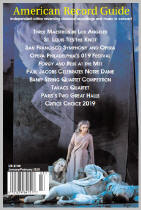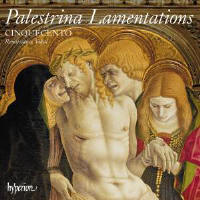Reviewer: Willian
J. Gatens
The office of Matins is
ordinarily sung in three nocturns through the night, culminating in the
office of Lauds at daybreak. In the Sacred Triduum of Holy Week (Maundy
Thursday, Good Friday, and Holy Saturday) it was the custom in many places
to advance the office to the early evening of the preceding day and to
observe it with solemn polyphonic settings of the lessons and responsories.
The office came to be known as Tenebrae. The music recorded here is for the
first nocturn of each day, with lessons from the Lamentations of Jeremiah,
including the headings that introduce the lessons, the Hebrew initials that
stand at the heads of the verses, and the refrain, “Jerusalem, Jerusalem,
convertere ad Dominum Deum tuum”, which concludes each lesson.
In 1588 Palestrina published a set of Tenebrae lessons that has since come
to be known as Book 1. The music recorded here dates from some 30 years
earlier, when the composer was choirmaster at the Basilica of St John
Lateran. The primary source for this music is Lateran Codex 59, published in
the 19th Century by Pietro Alfieri. There are at least two other sets of
lessons reliably attributed to Palestrina and a third that is doubtful. As a
practical liturgical setting, the lessons of Book 2 cover a great deal of
text in settings that are concise but never sound rushed or compressed. They
project a somber sublimity and eloquence that help to explain why Palestrina
was so widely regarded as the ultimate exemplar of the vocal polyphonic
idiom.
The music is sung one voice to a part by the ensemble Cinquecento,
a group of five singers from Austria, Belgium, England, Germany, and
Switzerland. As Bruno Turner points out in his notes, this is the way the
music would have been performed in the papal chapels and many other Roman
churches in Palestrina’s day. The individual movements range from three to
eight parts, so three additional singers are involved. I would describe the
vocal tone as slightly reedy and well suited to the clear delineation of
contrapuntal lines. Most impressive is the excellent sense of phrase that
makes the music cohere without exaggerated dynamic contrasts. There are
dynamic inflections that help to shape the performances, but not so as to
compromise the quiet solemnity of the occasion. These are profoundly
expressive readings, not the dispassionate take-it-orleave-it approach we
hear too often. No one could ask for more technically polished singing.
Listeners attracted to this repertory will not go wrong with this.
The booklet gives full texts and translations. The track list
specifies which singers are performing what. As we have come to expect from
Hyperion, the recorded sound is very attractive: clear but with a warm
reverberation.
Fermer la fenêtre/Close window
|




